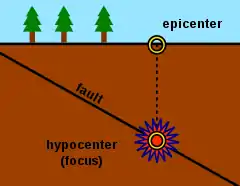Epicenter
The epicenter, epicentre (/ˈɛpɪsɛntər/) or epicentrum[1] in seismology is the point on the Earth's surface directly above a hypocenter or focus, the point where an earthquake or an underground explosion originates.

| Part of a series on |
| Earthquakes |
|---|
|
Surface damage
In most earthquakes, the epicenter is the point where the greatest damage takes place, but the length of the subsurface fault rupture may indeed be a long one, and damage can be spread on the surface across the entire rupture zone. As an example, in the magnitude 7.9 2002 Denali earthquake in Alaska, the epicenter was at the western end of the rupture, but the greatest damage was about 330 km (210 mi) away at the eastern end.[2] Focal depths of earthquakes occurring in continental crust mostly range from 2 to 20 kilometers (1.2 to 12.4 mi).[3] Continental earthquakes below 20 km (12 mi) are rare whereas in subduction zones earthquakes can originate at depths deeper than 600 km (370 mi).[3]
Epicentral distance
During an earthquake, seismic waves propagate in all directions from the hypocenter. Seismic shadowing occurs on the opposite side of the Earth from the earthquake epicenter because the planet's liquid outer core refracts the longitudinal or compressional (P-waves) while it absorbs the transverse or shear waves (S-waves). Outside the seismic shadow zone, both types of wave can be detected but, because of their different velocities and paths through the Earth, they arrive at different times. By measuring the time difference on any seismograph and the distance on a travel-time graph on which the P-wave and S-wave have the same separation, geologists can calculate the distance to the quake's epicenter. This distance is called the epicentral distance, commonly measured in ° (degrees) and denoted as Δ (delta) in seismology. The Láska's empirical rule provides an approximation of epicentral distance in the range of 2 000 − 10 000 km.
Once distances from the epicenter have been calculated from at least three seismographic measuring stations, the point can be located, using trilateration.
Epicentral distance is also used in calculating seismic magnitudes as developed by Richter and Gutenberg.[4][5]
Fault rupture
The point at which fault slipping begins is referred to as the focus of the earthquake.[3] The fault rupture begins at the focus and then expands along the fault surface. The rupture stops where the stresses become insufficient to continue breaking the fault (because the rocks are stronger) or where the rupture enters ductile material.[3] The magnitude of an earthquake is related to the total area of its fault rupture.[3] Most earthquakes are small, with rupture dimensions less than the depth of the focus so the rupture doesn't break the surface, but in high magnitude, destructive earthquakes, surface breaks are common.[3] Fault ruptures in large earthquakes can extend for more than 100 km (62 mi). [3] When a fault ruptures unilaterally (with the epicenter at or near the end of the fault break) the waves are stronger in one direction along the fault.[6]
Derivation and usage
The word is derived from the New Latin noun epicentrum,[7] the latinisation of the ancient Greek adjective ἐπίκεντρος (transl|grc|epikentros}}), "occupying a cardinal point, situated on a centre",[8] from ἐπί (epi) "on, upon, at"[9] and κέντρον (kentron) "centre".[10] The term was coined by the Irish seismologist Robert Mallet.[11]
It is also used to mean "center of activity", as in "Travel is restricted in the Chinese province thought to be the epicentre of the SARS outbreak."[12][13] Garner's Modern American Usage gives several examples of use in which "epicenter" is used to mean "center". Garner also refers to a William Safire article in which Safire quotes a geophysicist as attributing the use of the term to "spurious erudition on the part of writers combined with scientific illiteracy on the part of copy editors". Nevertheless, Garner has noted that these usages may describe "focal points of unstable and potentially destructive environments."[14]
References
- Oxford English Dictionary: "The point over the centre: applied in Seismol. to the outbreaking point of earthquake shocks."
- Fuis, Gary; Wald, Lisa. "Rupture in South-Central Alaska—The Denali Fault Earthquake of 2002". USGS. Retrieved 2008-04-20.
- Jordan, Thomas H.; Grotzinger, John P. (2012). The essential Earth (2nd ed.). New York: W.H. Freeman. p. 429. ISBN 9781429255240. OCLC 798410008.
- Tyler M. Schau (1991). "The Richter Scale (ML)". USGS. Retrieved 2008-09-14. Cite journal requires
|journal=(help) - William L. Ellsworth (1991). "Surface-Wave Magnitude (Ms) and Body-Wave Magnitude (mb)". USGS. Retrieved 2008-09-14. Cite journal requires
|journal=(help) - "What is Directivity?". earthquake.usgs.gov. Retrieved 2018-07-01.
- "epicenter". Merriam-Webster Online Dictionary. 2009. Retrieved 2009-10-19.
- ἐπίκεντρος, Henry George Liddell, Robert Scott, A Greek-English Lexicon, on Perseus
- ἐπί, Henry George Liddell, Robert Scott, A Greek-English Lexicon, on Perseus
- epicentre, on Oxford Dictionaries
- Filiatrault, A. (2002). Elements of Earthquake Engineering and Structural Dynamics (2nd ed.). Presses inter Polytechnique. p. 1. ISBN 978-2-553-01021-7.
- Rick Thompson (2004). Writing for Broadcast Journalists. Routledge. p. 160. ISBN 978-1-134-36915-7.
- Oltermann, P. (2009). How to Write. Random House. p. 246. ISBN 978-0-85265-138-4.
- Garner, BA (2009). Garner's Modern American Usage. Oxford University Press. p. 310. ISBN 9780199888771.